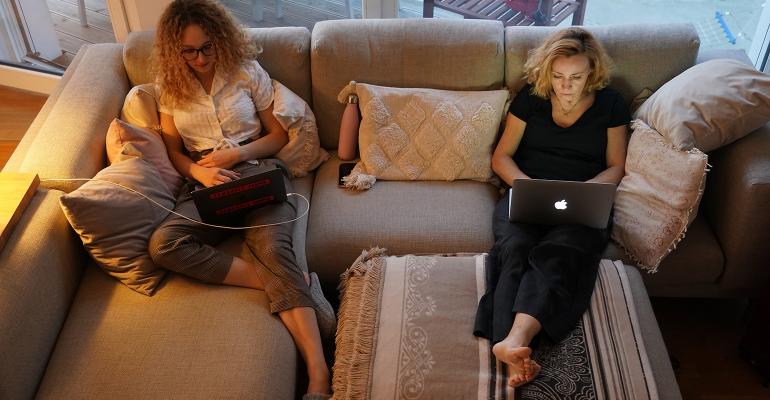(Bloomberg) -- Despite being homebound, Robert Khederian, a real estate salesperson at Compass, has been dressing up for a day of apartment showings and meetings. “Right now, I’m wearing khakis and a button-down, which is what I’d be wearing on a normal office day,” he said last Friday from his apartment in Manhattan, (This came, however, after wearing sweats most of the week). “It’s to give myself some sense of normalcy. It felt very good to take a shower, make the bed, and get dressed at a time that I normally would.”
His boyfriend John Maher, a specialist at the art auction house Sotheby’s, took a different approach. “Right now, I’m wearing blue chinos and a very casual T-shirt and slippers,” he said. “We started working remotely on Monday of this week, and there hasn’t been a single day I’ve put on a collared shirt.”
And so the quickly-spreading coronavirus, which has closed white collar offices across the country, has exacerbated the growing divide between formal and casual attire that has defined the uniform of corporate America over the last decade. (For proof, just look to the obsession over Mark Zuckerberg’s hoodies or Goldman Sachs’s “flexible” dress code.)
Complicating matters is videoconferencing software such as Zoom’s, which has allowed face-to-face meetings to move into the virtual realm. What rituals from before the quarantine are we expected to maintain? Must you dress up for a digital check-in with a colleague? What if it’s your boss? What if you are the boss? Is wearing a sport coat while working from the couch borderline insanity?
Strange questions, sure, but we live in strange times.
Some savvy brands are leveraging these uncharted waters to push a new type of hybridized clothing that straddles the line between work and home, formal and casual, suits and sweats. They promise the comfort of loungewear under the auspices of work-appropriate attire, and they feel especially attuned to our times.
Take, for example, the brand Nicestuff, founded last year, which has taken casual knit fabrics, as opposed to woven ones, and made from them garments most often seen in corporate environments: blazers, button-up shirts, and dress pants. Suddenly, these products seem particularly relevant.
“While working from home, we’re seeing that our customers feel the need to look presentable while on their work video calls,” said Nicestuff clothing adviser Tom Ott. “During tough times in the past, people have reverted to a more traditional way of dress with regard to business attire, but it doesn’t need to be uncomfortable. While appearing professional, we hope our products will keep our customers feeling more comfortable than they look."
Ott said Nicestuff experienced increased web traffic and higher conversions (i.e., sales) starting late in the week of March 9 as the Covid-19 coronavirus threat began escalating in the U.S., and quarantine measures were enacted in larger cities such as New York and San Francisco. Those two cities, Ott noted, are where Nicestuff’s sales have been concentrated.
Meanwhile Charles Tyrwhitt, the British clothier, used the quarantine to start promoting its textured wool blend drawstring suit, which costs $549. “It’s the home worker’s dream,”read a recent Tyrwhitt tweet. “A proper suit that looks sharp as ever on Skype, but has a drawstring waist and a soft construction that feels utterly relaxed.”
London-based Hamilton & Hare specializes in off-duty items such as loungewear, pajamas, and underwear. However its travel collection has suddenly been recast as the perfect work-from-home solution. Take the cotton waffle knit “suit,” originally intended for looking smart while traveling. Now, somewhat ironically, it might best be repurposed for a time when travel is forbidden—a way to look work-appropriate but feel cozy. (For virtual happy hours, you could even class it up with a beach blazer.)
Comfy-corporate items aren’t limited to faux suiting. California based brand Vince offers a button-up shirt made from a lightweight, velvety wool-cashmere blend, while Italy’s Brunello Cucinelli has a pair of pleated wool chalk-stripe trousers that may look boardroom ready but carry a living room-appropriate drawstring waistband.
The brand Alex Mill is selling what they call a “SUB” (short for sport utility blazer). It’s a mix between a classic tailored jacket and the more casual, trendy chore coat. It’s unlined and made from cotton, perfect for throwing over a T-shirt if you suddenly find your boss calling you via FaceTime.
Just remember that even though these items may feel relaxed, the rules of fit still apply. Schlubby is schlubby, whether it’s an ill-fitting blazer or your stained, stretched-out college T-shirt.
And if you’re really at a crossroads—is what’s appropriate for your co-worker videoconference appropriate for one with a client?—don’t be shy about asking a manager for guidance.
“We’re in uncharted waters, and there’s nothing wrong with making sure that everyone is comfortable and on the same page,” says Greg Payne, director of corporate communications at an industrial software company. “We’ve all got to have each other's backs right now.” For his first week at home—and to boost morale—Payne wore a full suit and tie before switching to a uniform of jeans and Henley.
At the end of the day, getting your work-from-home uniform down is about having a routine.
“I think I’d feel comfortable wearing a T-shirt,” Maher says of interfacing with colleagues via video chat. After a pause, however, he restates. “I say that now, but in the moment, I’d probably put on an Oxford. It might be a casual Oxford, but I probably wouldn’t just wear a T-shirt, truth be told.”
To contact the author of this story:
Max Berlinger in New York at [email protected]
To contact the editor responsible for this story:
Justin Ocean at [email protected]





